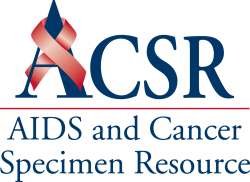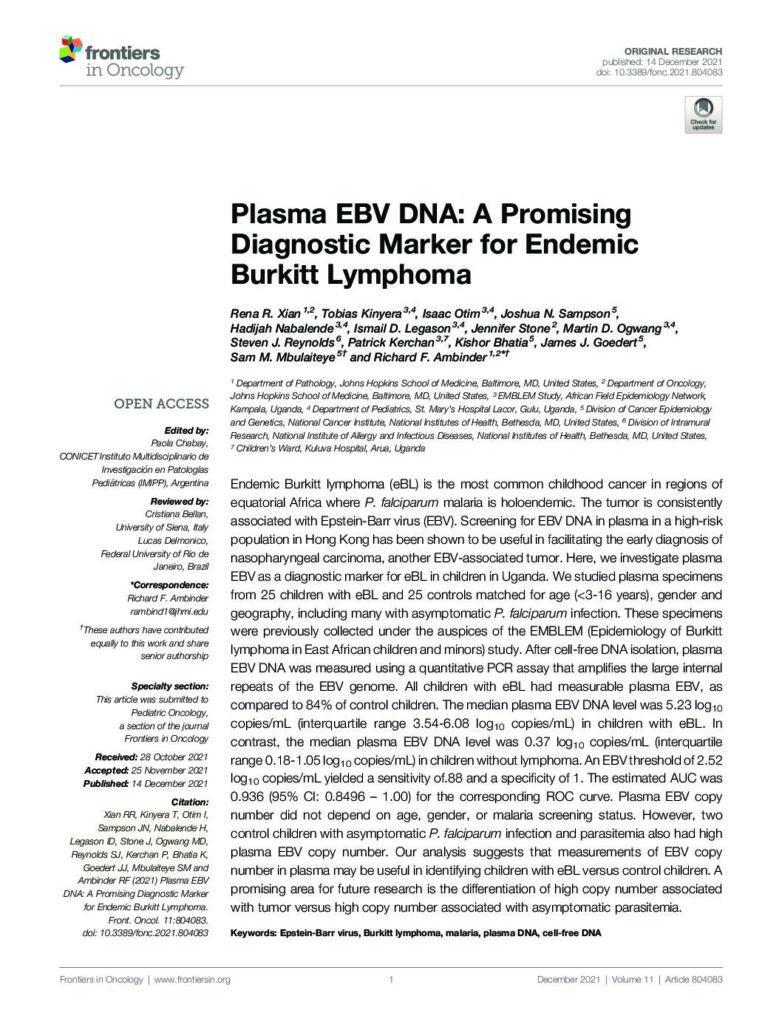As 2021 comes to a close, we celebrate some important work published by our colleagues (Ambinder, et al) who dedicate their careers to improving diagnosis, treatment and outcomes for people with cancer, both young and old, not only in the US but globally. In 2022, the ACSR will continue to support researchers with this shared vision: because together, we can end cancer as we know it.
AUTHOR=Xian Rena R., Kinyera Tobias, Otim Isaac, Sampson Joshua N., Nabalende Hadijah, Legason Ismail D., Stone Jennifer, Ogwang Martin D., Reynolds Steven J., Kerchan Patrick, Bhatia Kishor, Goedert James J., Mbulaiteye Sam M., Ambinder Richard F.
TITLE=Plasma EBV DNA: A Promising Diagnostic Marker for Endemic Burkitt Lymphoma
JOURNAL=Frontiers in Oncology
VOLUME=11
YEAR=2021
PAGES=5322
URL=https://www.frontiersin.org/article/10.3389/fonc.2021.804083
DOI=10.3389/fonc.2021.804083
ISSN=2234-943X
ABSTRACT=Endemic Burkitt lymphoma (eBL) is the most common childhood cancer in regions of equatorial Africa where P. falciparum malaria is holoendemic. The tumor is consistently associated with Epstein-Barr virus (EBV). Screening for EBV DNA in plasma in a high-risk population in Hong Kong has been shown to be useful in facilitating the early diagnosis of nasopharyngeal carcinoma, another EBV-associated tumor. Here, we investigate plasma EBV as a diagnostic marker for eBL in children in Uganda. We studied plasma specimens from 25 children with eBL and 25 controls matched for age (<3-16 years), gender and geography, including many with asymptomatic P. falciparum infection. These specimens were previously collected under the auspices of the EMBLEM (Epidemiology of Burkitt lymphoma in East African children and minors) study. After cell-free DNA isolation, plasma EBV DNA was measured using a quantitative PCR assay that amplifies the large internal repeats of the EBV genome. All children with eBL had measurable plasma EBV, as compared to 84% of control children. The median plasma EBV DNA level was 5.23 log10 copies/mL (interquartile range 3.54-6.08 log10 copies/mL) in children with eBL. In contrast, the median plasma EBV DNA level was 0.37 log10 copies/mL (interquartile range 0.18-1.05 log10 copies/mL) in children without lymphoma. An EBV threshold of 2.52 log10 copies/mL yielded a sensitivity of.88 and a specificity of 1. The estimated AUC was 0.936 (95% CI: 0.8496 – 1.00) for the corresponding ROC curve. Plasma EBV copy number did not depend on age, gender, or malaria screening status. However, two control children with asymptomatic P. falciparum infection and parasitemia also had high plasma EBV copy number. Our analysis suggests that measurements of EBV copy number in plasma may be useful in identifying children with eBL versus control children. A promising area for future research is the differentiation of high copy number associated with tumor versus high copy number associated with asymptomatic parasitemia.

